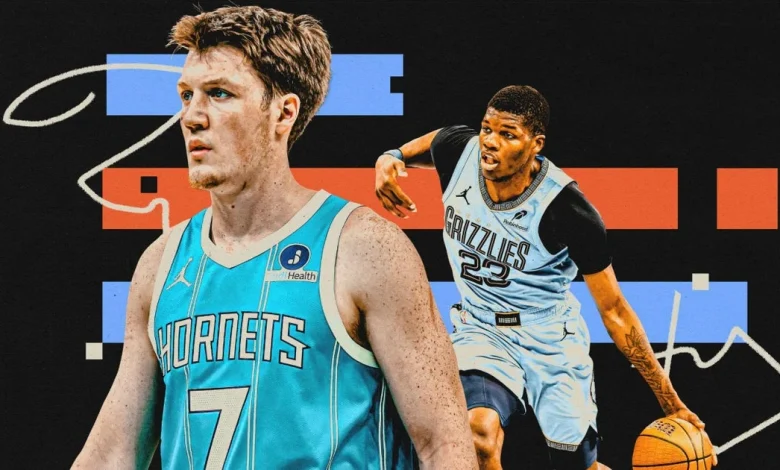NBA Rookie Rankings: Kon Knueppel, Cedric Coward stand out early

It’s time for the season’s first edition of the NBA Rookie Rankings, and I can’t emphasize enough how much more exciting this class is as compared to last season’s group.
Last year, very few rookies were productive in a way that actually had a chance to impact winning basketball — especially early. So far in 2025-26, I can point to several first-year players who are positively impacting their team’s bottom line, from the top-three players ranked here who were all selected in the top 10 to the second-rounders who round out my top 10.
A refresher on this exercise: We rank the league’s top 15 rookies, based on how they have played in the NBA thus far, not as a projection of who they will become.
What do I look for when I rank players? Minutes and roles matter. What is each rookie getting asked to do? How often are they seeing the court? Are they being asked to create offense? Is their role limited, and how successful are they in that role? How successful is the team with them within that role? What is the degree of difficulty of said role? Is the player logging major minutes on a good team or eating up minutes for a bad team?
This is an art, not a science. The rankings involve examining numbers and analyzing a painstaking amount of tape; I value the latter more.
I’ll highlight three of the rookies in-depth and then offer notes on the rest of the rankings. (Stats below are entering Thursday’s games.)
Knueppel picks up slack without LaMelo
The injury bug has again hit LaMelo Ball and Brandon Miller, forcing the Charlotte Hornets to rely on rookies to salvage what had been an extremely competitive start to their season. In the five games Ball has missed, the Hornets are 2-3 with a couple of brutal losses. However, the play of the rookies has been a true bright spot, and Kon Knueppel is the main reason why.
Over this five-game stretch, Knueppel is averaging 21.8 points, 8.4 rebounds and four assists while posting a 61.1 true shooting percentage. When Knueppel leaves the court, the Hornets are blown out by about 30 points per 100 possessions. He’s taken over as the primary offensive option and is playing remarkably well while doing so. Stepping into a larger role while maintaining the same level of high-end play is a situation Knueppel knows quite well from his time at Duke — he did the same thing in the ACC tournament when Cooper Flagg went down with a sprained ankle. He won the ACC tournament MVP award and led the Blue Devils to the title.
What’s been most fun about Knueppel in Charlotte is how coach Charles Lee is using him within the offensive scheme. He’s being weaponized as a movement shooter, with the ability to fly off different screening actions like curls or flares. He sets killer on-ball screens with contact thanks to his strength, but he also has the IQ to know when to slip them into open space. Knueppel’s intelligence off the ball is also elite, as he relocates sharply into dangerous areas off teammates’ drives and offensive rebounds and also finds buckets off cuts. Already, NBA teams have been forced to treat him like the elite shooter he is, opening up space for teammates like Collin Sexton to drive. He’s also a sharp passer who makes quick reversals and finds open teammates with ease.
All of this opens up his ability to drive, which has long been an underrated skill. Knueppel is not the most athletic player around, but he knows how to get defenders off-balance and understands exactly how to use angles and leverage to get where he needs to go. If a defender closes out too heavily on his shot — which happens often because of how good a shooter he is — he knows exactly how to pump fake, attack the front foot and drive right by to get a paint touch.
The following video is a great example of Knueppel combining basically everything above into one action. Knueppel comes down and sets an early screen for Sexton but decides to vacate to the corner when he realizes the team is in zone. He watches Sexton and Ryan Kalkbrenner play a bit of a two-man game before Miles Bridges gets it and attacks downhill. That makes Knueppel drift deeper into the corner as Marcus Smart helps up. Bridges finds the pass to Knueppel in the corner, and Smart has to close out heavily on the shooter. But Knueppel pump fakes, drives to the middle of the zone and finds a beautiful little 12-footer for an easy bucket.
Knueppel is an incredibly versatile offensive weapon. If you want to use him as your secondary ballhandler, he’s good enough to do that and initiate some sets. If you want to use him next to Ball as a screening weapon on the ball, you can do that. He can run off-ball actions, and if you want him to be a pure spacer in the corner, he’s about as good as it gets because of how he moves and shoots. In today’s NBA, there are so many ways that you can employ a player like this with how intricate offenses are. Already, he’s found a landing spot in Charlotte, with a top-10 3-point rate league-wide and a coach willing to get creative.
That’s how you end up with a rookie averaging 16.6 points per game on a true shooting percentage about 3 percent above league average while posting over two assists per game. Don’t sleep on his rebounding, either, which has helped the Hornets post a top-two defensive rebounding rate. He averages six per game, nearly all of which end defensive possessions and give him a chance to lead the break or outlet it to another guard and then either trail the play for an open 3 or spray out to the 3-point line.
Knueppel’s run here without Ball has been more impressive than any stretch from either of the other top two on this list, because of how he’s thrived as more of a primary option.
Coward doing it all efficiently for Memphis
Cedric Coward was one of the guys whom I shouted to the high heavens about before the draft. He was one of my favorite players in the class, as referenced in the intro to the 2025 NBA Draft Guide. And still, I did not see this start to his career coming. Last Friday night, Coward became the first player in NBA history to average at least 15 points per game while shooting at least 50 percent from the field, 40 percent from 3 and 90 percent from the foul line in the first 10 games of his career. To say he’s been a monster for a first-year player is understated. He’s coming off the bench in Memphis and is wrecking games with his efficient, intelligent method of getting shots.
Essentially, everything Coward did at Washington State last season has translated splendidly to the NBA. Mostly, that comes down to his efficiency of movement. Outside of his gathers at the rim — something we’ll circle back to — he never seems to make extraneous, unnecessary steps around the court. Early in the season, he was very effective as an off-ball player, drifting around the court and finding open shots through sharp off-ball movement and high-level transition play. While guys around him created advantages, he cleaned them up in a big way and drilled open 3s with impunity.
And in just these 11 games he’s played, Coward has grown in confidence and started hunting shots. Yes, he’s still lethal off the ball as a shooter, and teams must account for where he is at all times because of his fluid 3-point stroke. He gets into those shots so quickly because his shot prep is elite, always ready to fire in one motion off the hop. Where he’s already showing development is in his willingness to find early offense when it’s available. This is a good example of that against the Houston Rockets, when his first foray gets cut off by Alperen Şengün walling him up. Instead of picking up the ball and finding an outlet, he resets by keeping his dribble alive, waits for the screen by Jaren Jackson Jr. and finds his way to the elbow for a beautiful midrange pull-up.
Because he’s 6-foot-6 with a 7-foot-2 wingspan and a nice, high release point, that jumper is going to be exceptionally difficult to stop. And this is where you can see exactly where the upside comes into play too. Coward isn’t strong enough yet to bully his way to his spots and establish position wherever he wants. But down the road, with how well proportioned his frame is, it seems he could fairly easily put on 15 to 20 pounds and use his lower center of gravity and improved strength through his shoulders to move mismatched players backward to get to his spots, before simply shooting over the top of them.
The other place where strength would help Coward immensely is on his drives to the rim. Coward is making about 63 percent of his shots at the rim, per Synergy, and getting about four of them per game. However, most of them are coming in transition, and his half-court finishing has been spotty. When limited to the half-court attempts, Coward is making just 50 percent of his looks, and the big culprit is his footwork. It seems like Coward was taught from a young age to consistently play off two feet and load into every jump. But in the NBA, those windows close quickly at the rim, and players are too big and strong to leap over them and finish over the top. More craft and nuance are required to decelerate, absorb contact on drives and go up off one foot. That’s the next step for Coward.
This play against the Oklahoma City Thunder is a perfect example, as Coward gets an angle on Brooks Barnhizer in transition but takes a wide angle as Barnhizer bumps him while getting back in the play. Coward then decides to leap off two feet before getting swatted.
While Coward is already 22 years old, he hasn’t played in locations with the best strength-and-conditioning programs. There is massive room for growth here as he matures, especially given the leaps he seems to take every summer. That also holds true on the defensive end, where he’s already been quite good because of his instincts, length and switchability, but where he has potential to be even better with more strength through his torso.
If you made me bet on stars to develop from the 2025 draft class right now, Coward’s name would be in my first four picks.
Flagg a victim of Mavericks’ mess
Cooper Flagg’s issues in Dallas have probably been overstated to this point. It’s worth remembering that he’s not the only player dubbed a generational prospect to struggle early on. LeBron James averaged 16 points per game and shot 39 percent from the field, 31 percent from 3 and 70 percent from the line in his first 20 games. Anthony Davis averaged 13 points per game and had a 1-to-3 assist-to-turnover ratio in his first 25 games. Even Victor Wembanyama’s first 25 games were odd, because the San Antonio Spurs trotted out the Jeremy Sochan-at-point-guard experiment while slotting Zach Collins next to Wembanyama in the starting lineup for a portion of those games. Wemby did average 18 points and 10 rebounds, but he also had a negative assist-to-turnover ratio and shot just 43 percent from the field and 28 percent from 3.
Flagg is younger than Davis and Wembanyama were as rookies and, similarly to Wemby, is being played in a context that is among the most nonsensical I’ve seen in my years covering the NBA.
The Mavericks began the season with Flagg — who had never played point guard at any level — starting at the lead guard spot next to two bigs in Davis and Dereck Lively II, a player best suited to the four position in P.J. Washington and a 35-year-old Klay Thompson whose best years seem to be behind him. Dallas coach Jason Kidd tried this experiment with Giannis Antetokounmpo in 2015-16 with the Bucks, but two key factors make this drastically different. First, Giannis was 21 and had been in the NBA for three years. Second, the team around him also made drastically more sense. Khris Middleton could handle the ball as a wing and play out of ball screens. That Bucks team also started Jerryd Bayless, O.J. Mayo and Michael Carter-Williams next to Giannis, true ballhandlers who could actually make life easier for him.
Early on this season, the Mavericks were giving Flagg nothing to work with in terms of secondary ballhandlers or space to operate. Everything was so premeditated and obvious. There was no spontaneity because they had to get out and fly in transition or run sets to get any sort of paint touch. Every team seemed to anticipate their actions so quickly because they had no one who could play jazz and just get a paint touch while manipulating off-ball defenders. It resulted in truly catastrophic outcomes. In the 107 minutes the Mavericks played with Flagg on the court without either D’Angelo Russell or Brandon Williams, the team scored 96.5 points per 100 possessions — in an era when the league average is 115.3.
Flagg’s true shooting percentage was 46.2 when he played without Russell and 44.9 percent when he played without Williams. Simply put, the team failed to create any opportunities for him to get an easy look and gave him no space to drive to create one.
The one piece of good news for Mavericks fans is that the team has figured out that it can’t surround Flagg without ballhandlers anymore. Dallas has moved Russell or Williams into the starting lineup, and the results have already been better. In the five games since that change, Flagg is averaging 17.2 points while shooting 45.9 percent from the field, even during a cold shooting spell in which he’s made only 6-of-23 from 3. With Williams on the court, Flagg is averaging 23.6 points per 75 possessions (up from 12.9 without him), per Databallr, with a 60.9 true shooting percentage. With Russell on the court, he posts a 57.2 true shooting percentage. And when Flagg plays with Williams, the team averages 111.7 points per 100 possessions.
On Monday, Flagg had the best game of his career against Milwaukee, scoring 26 points on 9-of-15 from the field with nine rebounds and four assists. Beyond the stats, the team looked far more capable of creating advantageous situations for Flagg to beat mismatches. This play below late against the Bucks to give the Mavericks the lead with about two minutes remaining is exactly what I’m talking about. Instead of being asked to be the ballhandler immediately, he’s the first screener in a double drag, in which NBA teams typically switch the action. That gets Flagg matched up on 6-4 Ryan Rollins while catching the ball on the move, and he takes advantage by driving and shooting over the top of him with ease.
At some point soon, this Mavericks roster is going to have to be blown up. After firing general manager Nico Harrison, the team’s goal should be to surround Flagg with as many two-way players and shooters as possible while also making sure to maintain positive point guard play. This was the exact strategy they employed with Luka Dončić, and the result was an NBA Finals appearance.
Flagg is still a rising superstar in the NBA. The team just needs to give him the chance to develop within a situation that makes sense, much like the Detroit Pistons have learned with Cade Cunningham.
Other notes
• I chose not to write about VJ Edgecombe this month, but we’ll handle that soon. I’ve loved the way the Philadelphia 76ers have played to Edgecombe’s strengths while minimizing his weaknesses. Edgecombe is a superb athlete who can fly around the court and knock down catch-and-shoot 3s. Where he struggles is consistently creating advantages in half-court situations and hitting pull-up jumpers. So Philly has essentially tied him to Tyrese Maxey’s hip, playing him with the All-Star lead guard for 326 of his 410 minutes so far this season. When he’s out there with Maxey, Edgecombe has a 54.7 true-shooting percentage, versus a 40.4 percent mark without him, per Databallr. Edgecombe has terrific qualities, including as a shooter, passer and defender, but shot creation isn’t one of them yet. We’ll see how that develops, but he’s been a remarkably valuable player while averaging 15 points, five rebounds and four assists with positive defensive play.
• I’ve appreciated Dylan Harper’s two-way impact for the Spurs while averaging 14 points, four rebounds and four assists and shooting 50 percent from the field, 36 percent from 3 and 83 percent from the line. He’s been a menace in transition, upping the tempo when he gets in the game with his ability to get downhill. I’ve also loved his defensive aggressiveness at the point of attack, as he’s taken license to crawl into his opposition’s space, knowing that even if he gets beaten, Wembanyama is sitting behind him. Harper is out with his calf injury, but his first six games were quite impressive.
• The 7-foot Ryan Kalkbrenner has been one of the most efficient bigs in the NBA so far, averaging 9.9 points and 6.8 rebounds for the Hornets while shooting an absurd 83 percent from the field (he went 8-of-8 against Milwaukee on Wednesday). He’s also blocking 2.4 shots per game, and while drivers have caused him issues, Charlotte is two points better per 100 possessions and seems to have a better defensive infrastructure when he’s on the court.
• The New Orleans Pelicans’ duo of Derik Queen and Jeremiah Fears has been fun, throwing up some dizzying highlights and painfully difficult low moments. Queen has been in the lineup less consistently than Fears, but I’ve liked his offensive flashes more thanks to his natural feel for the game. Queen’s passing and IQ have stood out, as he’s tossed up seven- and eight-assist games. His slow-mo style of play has been enjoyable to watch as teams try to find ways to stay in front of him, and he’s created a lot of shots in his limited minutes. Coordination and balance are his superpowers, and he’s fooling defenders every game with them. Ultimately, the question for Queen will be how he finds a way to score efficiently, given that he has a true shooting mark 10 percent below league average. He’s never been much of a shooter, and he’s not an above-the-rim finisher who can create easy shots by diving to the rim regularly. Still, the flashes to be a high-end playmaker are there.
Jeremiah Fears’ upside for the Pelicans has been evident early on. (Daniel Dunn / Imagn Images)
Fears’ flashes have also been loud. Teams can’t keep him out of the paint. His speed is ridiculous when mixed with his handle. His true shooting percentage is about 15 percent below league average, but his ability to buzz in and out of the paint makes you want to buy into his upside if he ever gets the shot and decision-making tree figured out. He’s got a real chance to be more than just a good sixth man.
• Will Richard and Sion James are two older rookies who have done their job in a Bill Belichick-ian sense, achieving exactly what has been asked of them: Take on tough defensive assignments, knock down perimeter shots, move without the ball and make decisions. Richard has averaged 9.4 points on 58 percent from the field, 44 percent from 3 and 78 percent from the line in 18 minutes per night. He’s essentially making himself unbenchable for the Golden State Warriors, even when the team is fully healthy, and was moved into the starting lineup on Wednesday. His run last weekend, while some of the team’s stars sat out, was the most impressive part of his season. He averaged 19 points, including a 30-point breakout against the Sacramento Kings.
• Collin Murray-Boyles and Tre Johnson were the last two clear selections here. Murray-Boyles has been fun with his active defensive play, and when Jakob Poeltl sat out with an injury, I appreciated the way that the Toronto Raptors used Murray-Boyles as a screener and short roller. That’s where he is most valuable on offense. Johnson is averaging 12 points per game and knocking down 39.7 percent of his 3-point attempts for the Washington Wizards. He’s essentially doing what we expected, and I wouldn’t be surprised to see him encroach on even more of Bub Carrington’s minutes with Carrington’s catastrophic start to the season.

![2025 Jiangxi Open: Tagger [235th] vs. Zhu Prediction, Odds and Match Preview](https://cdn1.emegypt.net/wp-content/uploads/2025/10/2025-Jiangxi-Open-Tagger-235th-vs-Zhu-Prediction-Odds-and-390x220.webp)



